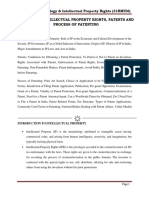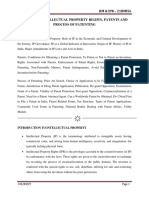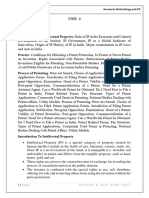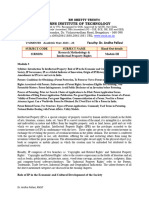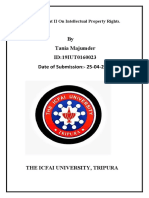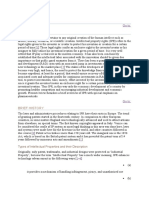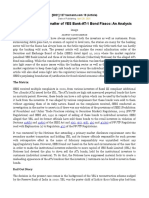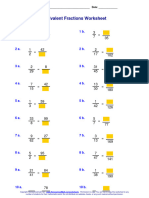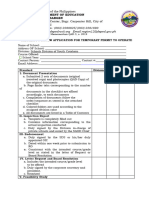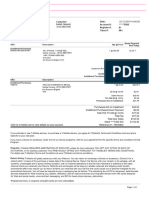Mod 3
Uploaded by
sce22am021Mod 3
Uploaded by
sce22am021BRMK557 – Research Methodology & Intellectual Property Module: 3: Introduction to Intellectual Property
MODULE 3: INTELLECTUAL PROPERTY RIGHTS, PATENTS ANDPROCESS OF PATENTING
Syllabus
Introduction to Intellectual Property: Role of IP in the Economic and Cultural Development of the Society,
IP Governance, IP as a Global Indicator of Innovation, Origin of IP, History of IP in India, Major Amendments
in IP Laws and Acts in India.
Patents: Conditions for Obtaining a Patent Protection, To Patent or Not to Patent an Invention, Rights
Associated with Patents, Enforcement of Patent Rights, Inventions, and Eligible for Patenting, Non-
Patentable Matters, Patent Infringements, Avoid Public Disclosure of an Invention before Patenting.
Process of Patenting: Prior Art Search, Choice of Application to be Filed, Patent Application Forms,
Jurisdiction of Filing Patent Application, Publication, Pre-grant Opposition, Examination, Grant of a
Patent, Validity of Patent Protection, Post-grant Opposition, Commercialization of a Patent, Need for a
Patent Attorney/Agent, Can a Worldwide Patent be Obtained, Do I Need First to File a Patent in India,
Patent Related Forms, Fee Structure, Types of Patent Applications, Commonly Used Terms in Patenting,
National Bodies Dealing with Patent Affairs, Utility Models
INTRODUCTION TO INTELLECTUAL PROPERTY
Intellectual Property (IP) is the terminology attributed to intangible assets having commercial
value, and arising from human intelligence, creativity, and imagination, but typically lacking
physical form.
Intellectual Property Rights (IPR) is the privileges accorded to the creator/inventor (of IP) in
conformance with the laws. These rights are given to the creator/inventor in exchange for revealing
the process of creation/invention in the public domain. The inventor is conferred with the special
rights to use, sell, distribute, offering for sale and restricting others from using the invention without
his prior permission
Broadly, IP comprises of two branches i.e. Copyrights and Related Rights and Industrial Property
Rights.
Copyrights and Related Rights refer to the creative expressions in the fields of literature and art,
such as books, publications, architecture, music, wood/stone carvings, pictures, portrays
sculptures, films and computer-based software‘s/databases.
The Industrial Property Rights refer to the Patents, Trademarks, Trade Services, Industrial Designs
and Geographical Indications
Copyright: Copyright is the right bestowed on the owner or creator in relation to publication, and
distribution of a piece of writing, music, picture or related works.Copyright also applies to technical
contents such as software, datasheets and related documents.
Patents: A patent is a legal record that bestows the holder the exclusive right over an invention as
Reshma Farhin J,AP,, Dept. of AIML, SCE, 1
Bengaluru
BRMK557 – Research Methodology & Intellectual Property Module: 3: Introduction to Intellectual Property
per the claims, in a limited geographical domain and for a limited duration by thwarting possible
interested parties from any form of manufacture, use or sale of the product or outcome of the
invention
Trademarks: A trademark is a sign that suitably differentiates the owner‘s goods or services from
those of others
Trade services: Any services in relation to trade or any trade related financing, lending or other
financial accommodation provided(or to be provided) by the bank, including but not limited to
issuance/amendment of letter of credit, document arrival under letter of credit, application for
negotiation and inquiries etc.,
Industrial Designs: An industrial design protection is related to certain specific ornamental shapes
associated with products whose duplication the owner may wish to prevent
Geographical Indications: A geographical indication (GI) is a name or sign used on products which
corresponds to a specific geographical location or origin. Items that meet geographical origin and
quality standards may be endorsed with a government-issued stamp which acts as official
certification of the origins and standards of the product.
ROLE OF IP IN THE ECONOMIC AND CULTURAL DEVELOPMENT OF THESOCIETY
Creativity being the keystone of progress, no civilized society can afford to ignore the basic
requirement of encouraging the same. The economic and social development of a society is largely
dependent on creativity.
The protection provided by the IPR to the creators/innovators is in fact an act of incentivization for
encouraging them to create more and motivates others to create new.
However, if IPR is practiced rigidly, it may have a negative impact on the progress of society. For
example, compliance with the Trade-Related Aspects of Intellectual Property Rights (TRIPS)
Agreement has affected the farming community as they are unable to store seeds for the next crop.
Multinational companies regulate the price of seeds, which is generally beyond the reach of a
majority of the farmers.
To circumvent the negative impact of IPR, certain laws, exceptions and limitations associated with
IPR have been enacted to maintain a balance between the interests of the creators/inventors and
the community.
For example, farmers rights under the Protection of Plant Varieties and Farmers Rights (PVP&FR)
Act, 2001 entitles them to many privileges, such as Rights on seeds provides rights to the farmers
to save seeds, use seeds and share, exchange or sell seeds to other farmers.
Right to protection against accusations of infringement protects the farmers from infringement and
other legal accusation levied upon them due to his legal ignorance in using other‗s plant varieties.
The use of copyrighted material for education and religious ceremonies is exempted from the
Reshma Farhin J,AP,, Dept. of AIML, SCE, 2
Bengaluru
BRMK557 – Research Methodology & Intellectual Property Module: 3: Introduction to Intellectual Property
operation of the rights granted in the Copyright Act.
Similarly, a patent can be revoked in favor of compulsory licensing by the government during an
emergency or a natural calamity.
In addition, if an invention/creation is not in the interest of society, it is not registered by the
government for grant of any rights associated with IP. For example, cloning of human embryos is
banned for IP protection, and so is the creation of super microbial pathogens, which can play havoc
with human lives.
IP GOVERNANCE
Since IP is an integral component of human society, each and every nation has dedicated agencies
for laying out the guidelines, implementation and enforcement of IP related matters.
In India, many organizations/agencies deal with various aspects of IP. The governance of all
categories of IP, except the Plant Variety and Farmers Rights Act, is carried out by the Department
for Promotion of Industry & Internal Trade (DPIIT) under the aegis of Ministry of Commerce and
Industry, Govt. of India.
There are a few other dedicated organizations/departments established by the government to
promote patent-ecosystem (patent awareness, patent filing and patent commercialization) in India
e.g. Technology Information Forecasting and Assessment Council (TIFAC), National Research
Development Corporation (NRDC) and Cell for IPR Promotion and Management (CIPAM), etc.
In order to create a hassle-free exchange of IP related activities amongst all the nations, it is
imperative to have minimum standards of rules and regulations pertaining to all aspects of IP
including rights, empowerment, exceptions, etc.
To achieve this goal, the United Nations (UN) has established an organization called the World
Intellectual Property Organization (WIPO).
This agency is at the forefront of imparting knowledge about IP and governs international filing
and registration of IP through various Conventions and Treaties like Paris Conventions, Patent
Cooperation Treaty (PCT), Rome Convention, Berne Convention, etc.
IP AS A GLOBAL INDICATOR OF INNOVATION
IP, especially patents, is considered as one of the important cogs in assessing the innovation index
of a nation.
The global ranking organizations always have IP or a subset of IP as one of the parameters for
understanding and grading the Science, Technology and Innovation (STI) ecosystem of a nation.
For example, the Scim ago (publically available online portal which ranks journals and countries
based on the data taken from Scopus) 2020 report ranked India at 4th position in the parameter of
a number of Research Publications and 50th position in the parameter of Intellectual Property
Reshma Farhin J,AP,, Dept. of AIML, SCE, 3
Bengaluru
BRMK557 – Research Methodology & Intellectual Property Module: 3: Introduction to Intellectual Property
Rights.
The global ranking can be improved by sensitizing the teaching and scientific communities about
the importance of IP and creating infrastructure for the same in the institutes of higher learning.
ORIGIN OF IP
Though there is no official record of the origin of IP, it is believed that a rudimentary form of IP was
being practiced around 500 Before the Common Era (BCE) in Sybaris, a state of Greece.
The natives of Sybaris were granted a year‗s protection for using their intellect to create
any new improvement in luxury.
A practical and pragmatic approach for IP governance started taking shape in medieval Europe. In
1623, Britain passed an Intellectual Property Legislation which entitled guilds (association of
artisans or merchants) to create innovations and bring them to market for trade purposes.
However, this legislation brought a lot of resentment amongst the public, and thus was replaced by
the Statute of Monopolies‗, which gave the rights to the original creator/inventor for 14 years.
Another legislation, Statute of Anne‗, was passed by the British parliament in 1710.
This legislation aimed at strengthening copyrights by providing rights to the authors for recreation
and distribution of their work. The work could also be renewed for another 14 years.
By the end of the 18th century and the beginning of the 19th century, almost every country started
laying down IP legislation to protect their novel inventions and creations.
HISTORY OF IP IN INDIA
Patents
The history of the Indian patent system dates back to the pre independence era of British rule. The
first patent related legislation in India was Act VI of 1856, adapted from the British Patent Law of
1852. The objective of this legislation was to encourage the inventions of new and useful
manufactures.
At the beginning of the 20th century, all the earlier Acts related to inventions and designs were
done away with the introduction of ―The Indian Patents and Designs Act‖ 1911 (Act II of 1911).
As per this Act, the governance of patents was placed under the management of the Controller of
Patents. In the next three decades, many amendments were introduced for reciprocal arrangements
with other countries for securing priority dates. These amendments dealt with;
Use of invention by the government
Patent of Addition
Enhancing the term of the patent from 14 years to 16 years.
Filing of Provisional Application and submission of Complete Application within 9 months
Reshma Farhin J,AP,, Dept. of AIML, SCE, 4
Bengaluru
BRMK557 – Research Methodology & Intellectual Property Module: 3: Introduction to Intellectual Property
from the date of filing the application.
Keeping the national interest in mind, recommendations were made in 1949 as a
modification to existing ―The Indian Patents and Designs Act‖. And those
recommendations are as follows
Misuse of patents rights needs to be prevented.
There must be a clear indication in the Act that food, medicine and surgical and curative devices
should be made available to the masses at the cheapest rate by giving reasonable compensation
to the owner of the patent.
Amendments in Sections 22, 23 and 23A of the Patent and Design Act, 1911 on the lines of the
UK Patent Act.
These recommendations were introduced in the Act XXXII of 1950.
Two years later, another amendment (Act LXX of 1952) was made to provide compulsory licensing
of patents related to food, drugs and chemicals killing insects and microbes. Based on these
amendments, a bill was presented in the parliament in 1953 but was rejected.
In 1957 a committee was constituted and the committee submitted its report to the government in
1959. It comprised of two segments addressing
General aspects of the patent laws, and
Bill rejected back in 1953.
The revised patent legislation was submitted to the Lok Sabha in 1965. After many hiccups,
clarifications and modifications the Patents Act, 1970
In 1999, The Patents (Amendment) Act, 1999 was introduced providing for the filing of applications
for ‗Product Patents‗ in the areas of drugs, pharmaceuticals and agrochemicals
The new Patent Act also included provisions for the grant of Exclusive Market Rights (EMRs) for the
distribution and sale of pharma products on fulfillment of certain conditions. The second
amendment to the 1970 Act was made through the Patents(Amendment) Act, 2002 (Act 38 of 2002).
This Act introduced new Patent Rules, 2003, thus replacing the earlier Patents Rules, 1972.
With the rapidly changing scenario of IPR at a global level, a need was felt to further amend the
Patent Act, 1970. The highlight of the Patents (Amendments) Act 2005 were:
Product patent for inventions in all fields of technology.
New forms of known substances excluded to prevent ever greening of the patent.
Rationalization of the opposition procedure.
Introduction of pre-grant opposition by representation.
Introduction of post-grant opposition.
Compulsory license for export purposes.
Compulsory license for manufacture.
Reshma Farhin J,AP,, Dept. of AIML, SCE, 5
Bengaluru
BRMK557 – Research Methodology & Intellectual Property Module: 3: Introduction to Intellectual Property
Extension of grace period from 6 months to 12 months for filing a patent, if published in
government exhibition.
Copyrights and related rights
The concept of copyrights started way back in the 15th century. However, the actual need for
copyrights law was felt only after the invention of printers and copiers.
Before the invention of printers, writing could be created only once. It was highly laborious and the
risk of errors was involved in the manual process of copying by a scribe.
The evolution of copyrights law in India occurred in three phases. First, two phases were enacted
during the British Raj.
In the first phase, the concept of copyrights was introduced in 1847 through an enactment
during the East India Company‗s regime. The term of copyrights was for the lifetime of the
author plus seven years after death. The registration of copyright was mandatory for the
enforcement of rights under the Act. The government could grant a compulsory license to
publish a book if the owner of the copyright, upon the death of the author, refused to allow its
publication.
In the second phase Indian legislature, under the British Raj, enacted the Copyright Act of 1914
based on the Imperial Copyright Act (1911) of the UK. An Act for criminal sanction for an
infringement was introduced.
The third phase of the copyright’s regime was witnessed post-independence. The Copyright Act
1957 was enacted, superseding the Indian Copyright Act, 1914, in order to suit the provisions of
the Berne Convention (1886).
The 1957 Act has been amended six times (1983, 1984, 1992, 1994 and 1999, 2012), to comply with
WIPO Copyright Treaty (WCT), 1996 and WIPO Performances and Phonograms Treaty (WPPT),
1996.
India is an active member of nearly all significant international Conventions/Treaties related to
Copyright Law e.g. the Berne Convention as modified in Paris in 1971, the Universal Copyright
Convention (1951), the Rome Convention (1961), WCT, WPPT and(TRIPS, 1995).
Trademarks
The first statutory law related to Trademarks (TM) in India was the Trade Marks Act, 1940, which
was carved out from the Trade Marks Act, 1938 of the UK.
It was followed by the incorporation of provisions of TM stated in the Indian Penal Code, Criminal
Procedure Code and the Sea Customs Act.
Later on, Trade Marks Act, 1940 was rechristened as Trade and Merchandise Marks Act, 1958.
Nearly four decades later, this Act was repealed by the Trade Marks Act, 1999. The need for this
Reshma Farhin J,AP,, Dept. of AIML, SCE, 6
Bengaluru
BRMK557 – Research Methodology & Intellectual Property Module: 3: Introduction to Intellectual Property
occurred to comply with the provisions of the TRIPS. It is the current governing law related to
register TM.
Geographical Indications
India, as a member of WTO, enacted the Geographical Indications of Goods (Registration and
Protection) Act, 1999.
It came into force with effect from 15th September 2003. Geographical Indicators have been defined
under Article 22 (1) of the WTO Agreement on TRIPS.
Industrial Design
The need to protect Industrial Designs (ID) was recognized in the 18th century and the Indian
legislation enacted the ―Patterns and Designs Act‖ in 1872 for the first time. The Act was enacted
to protect the rights over the creation of the designs and novel patterns by the inventors.
The Act was replaced by the British Patents and Designs Act in 1907, which later became the basis
for the Indian Patents and Designs Act, 1911.
In 1970, a separate Act was enacted for the patent, i.e. the Patent Act, 1970. The Indian Patents and
Designs Act, 1911, remained in force for designs only.
Finally, in the year 2000, a dedicated Act for the ID was passed, which came into force in2001.
Semiconductor Integrated Circuits and Layout designs
In the 21st century, Information Technology (IT) has revolutionized the economic and societal
growth of the world economy.
The rapid and tremendous scientific advancements in the field of IT resulted in the creation of a
new class of IP called the Layout-Design of the Semiconductor Integrated Circuits. Various
organizations, including WTO and TRIPS Agreement laid down rules
and regulations regarding the protection of Semiconductor Integrated Circuits and LayoutDesigns
(SICLD)
India being a member of the WTO also passed an Act called the SICLD Act, 2000. This Act is TRIPS
compliant and fulfils the conditions of the TRIPS agreement (Articles. 35 to 38) concerning the
protection of SICLD.
Plant varieties
Till 1970s, not much emphasis was laid on patentable matter originating from animals and plants.
However, microbes and microbial products/processes were patentable.
To include all kinds of biological materials under the ambit of patent laws, a decision to enact a new
Reshma Farhin J,AP,, Dept. of AIML, SCE, 7
Bengaluru
BRMK557 – Research Methodology & Intellectual Property Module: 3: Introduction to Intellectual Property
sui generis law under the International Convention for the Protection of New Varieties of Plants
(UPOV, 1978) and UPOV, 1991 was taken.
These decisions were taken to address environmental and public interest concerns.
The Indian Patents Act, 1970 excludes ―plants and animals in whole or any part thereof other than
microorganisms‖ from patentability.
To comply with the mandate of Article 27.3 (b) of TRIPS, India adopted the Protection of Plant
Varieties and Farmers Rights (PPV&FR) Act, 2001 as a sui generis regime protecting not only new
plant varieties but also farmer‘s rights.
Biodiversity conservation
In 1927 the ―Indian Forest Act‖ and later on the ―Wildlife Protection Act‖ 1972 was enacted to
provide legal protection to biodiversity.
In 1988, the ―National Forest Policy‖ was passed, which brought revolutionary changes in the
conservation and management of biodiversity.
The Acts and policies in force to protect the environment and biodiversity in India include Mining
and Mineral Development Regulation Act, 1957; Water (prevention and control of pollution) Act,
1974; Forest Conservation Act, 1980; Biological Diversity Act, 2002; Scheduled Tribes and other
Traditional Forest Dwellers (recognition of rights) Act,2006; National Biodiversity Action Plan,
2009; National Environment Policy, 2006 and a few more.
MAJOR AMENDMENTS IN IP LAWS AND ACTS IN INDIA
In order to fill the gaps existing in the IP Laws and Acts and also to introduce new
guidelines/directions based on the current scenario (socially and politically), each nation keeps
on updating the concerned IP Laws and Acts. Some of the salient amendments made in Indian Laws
and Acts on IPR are mentioned below:
Sl. No Year Historical Proceedings
PATENTS
The Act VI of 1856 on the protection of inventions based on theBritish
1 1856
Patent Law of 1852.
Rights renamed as "Exclusive Privileges"
2 1859 Time for the priority increased from 6 months to 12 months.
The Patterns and Designs Protection Act
Introduction of novelty in the invention.
3 1883 A grace period of 6 months for the disclosure of the invention.
Renamed as "The Indian Patent and Design Act" and brought under
4 1911
the management of "Controller of Patents"
Introduction of Patent of Addition.
5 1930 Government can use the invention if required.
Reshma Farhin J,AP,, Dept. of AIML, SCE, 8
Bengaluru
BRMK557 – Research Methodology & Intellectual Property Module: 3: Introduction to Intellectual Property
The term of patent protection increased from 14 to 16 years.
Filing of the provisional specification to secure the priority date.
6 1945
Provision of submitting complete specifications within 9 months.
Dedicated Committee formed under the leadership of Justice Bakshi
Tek Chand for reviewing patent system as per the national
7 1949
Environment.
A working statement needs to be submitted at the Patent Office
Endorsement of the Patents with the words "License of Right‖ on the
application made by the government so that the Controller could
8 1950 grant the license.
Provision of "Compulsory License" in the areas of food, medicine and
insecticide germicide.
9 1952
Process for producing substance or any invention relating to surgical
or curative devices.
After in corporation of the recommendation submitted
10 1965 by the committee formed in 1949, a new bill was introduced in Lok
Sabha but was not cleared.
Again, submitted to Parliamentary Committee.
11 1967 1911 Act remained applicable for Designs.
12 1970 The Patent Act, 1970 passed by the Parliament Committee.
The Patent Act, 1970 came into force with the introduction of
13 1972
patent rules.
TRIPS Agreement was signed by India and got transition period
14 1995
1995-2005 to make domestic laws compatible with TRIPS.
Introducing the provisions for receiving the applications for the
product patent in the field of pharmaceuticals and agro-chemicals
(mail box)*.
Provisions for the grant of EMRs for distribution and sale of pharma
15 1999 products on fulfillment of certain conditions.
Grant of EMR subject to certain conditions. After the amendments
(1999) the product patents related to the pharmaceuticals and
agrochemicals were kept on hold for examination till 2005. It is
called a mailbox or black box.
The uniform 20-year term of the patent for all inventions.
Disclosure of source and geographical origin of biological material
16 2002 made compulsory.
Establishment of Appellate Board.
Compulsory License provisions strengthened.
17 2003 The Patents Rules, 2003 were introduced.
Product patent for inventions in all fields of technology including
food, drug, chemicals and microorganisms.
New forms of known substances excluded in order to prevent the
18 2005 ever-greening of the patent.
Introduction of the pre-grant opposition. Introduction of post-grant
opposition.
Extension of grace period to 12 months.
Reshma Farhin J,AP,, Dept. of AIML, SCE, 9
Bengaluru
BRMK557 – Research Methodology & Intellectual Property Module: 3: Introduction to Intellectual Property
COPYRIGHTS AND RELATED RIGHTS
The concept of Copyrights in India was introduced.
1 1847 Validity - Lifetime+7 years but not more than 42 years in total.
Copyright Act, 1914 was introduced based on the
2 1914 Imperial Copyright Act, 1911 of UK.
Copyright Act, 1914 was replaced with Copyright Act, 1957 with
3 1957 minor modifications
4 1984 Penalty on second and subsequent conviction
5 1994 Registration of Copyright Society made mandatory
To comply with international Treaties for copyrights protection in
thedigital environment.
6 2012 Right to receive royalties for authors and music composers.
Exception of copyrights for physically disabled persons to access
anywork.
7 2013 Copyrights Rules, 2013 introduced.
TRADEMARKS
1 1940 Trademarks Registry established in India.
The Trade and Merchandise Marks Act, 1958 enacted as per TRIPS
2 1958 Agreement.
Amended to avoid duplicity and ensure securing proprietors trade
3 1999 and goodwill
4 2002
Trademarks Rules introduced.
Amended to comply with Madrid Protocol for international filing.
5 2010 Provision for filing opposition of the registration within 4 months.\
6 2013 Trademarks Rules introduced.
GEOGRAPHICAL INDICATIONS
Being a member of the World Trade Organization (TRIPS), GI of
1 1999
goods (Registration and Protection) Act was introduced.
The Geographical Indications of Goods (Registration and
2 2002 Protection) Rules, 2002 was introduced.
The Geographical Indications of Goods (Registration &
3 2003 Protection) Act came into force
INDUSTRIAL DESIGNS/ DESIGNS
Patterns and Designs Protection Act introduced for the protection
1 1872 of new patterns and designs.
Amended as Invention and Design Act, 1988 for the protection of
2 1888 new inventions and designs.
3 1911 Renamed as The Indian Patent and Design Act.
Design Act, 2000 was introduced; separated from the Indian
4 2000 Patent and Design Act.
5 2001 Design Rules, 2001 introduced.
SEMICONDUCTOR INTEGRATED CIRCUITS: LAYOUT DESIGNS (SICLD)
Semiconductor Integrated Circuits Layout Design (SICLD) Act 2000
1 2000 introduced as a signatory of WTO.
2 2001 SICLD Rules introduced.
PROTECTION OF PLANT VARITIES AND FARMERS RIGHTS
Reshma Farhin J,AP,, Dept. of AIML, SCE, 10
Bengaluru
BRMK557 – Research Methodology & Intellectual Property Module: 3: Introduction to Intellectual Property
The Patent Act, 1970 excluded plants and animals in whole or in any
1 1970 part from patentability (in 1999 amendments).
Enactment of protection of new varieties of plants on sui generis
2 1991 basis on the lines of UPOV.
In line with TRIPS Agreement enactment of PPV&FR Act was
3 2001 introduced.
BIOLOGICAL DIVERSITY
The Biological Diversity Act, 2002 introduced on the lines of the
1 2002 Convention on Biological Diversity (CBD, 1992).
Establishment of National Biodiversity Authority.
2 2003 Designation of repositories under the Biological Diversity Act
3 2004 Biological Diversity Rules introduced.
Reshma Farhin J,AP,, Dept. of AIML, SCE, 11
Bengaluru
BRMK557 – Research Methodology & Intellectual Property Module: 3: Introduction to Intellectual Property
PATENTS
A patent is an exclusive right granted for an innovation that generally provides a new way of doing
something or offers a new technical solution to a problem.
The exclusive right legally protects the invention from being copied or reproduced by others.
In return, the invention must be disclosed in an application in a manner sufficiently clear and
complete to enable it to be replicated by a person with an ordinary level of skill in the relevant field.
CONDITIONS FOR OBTAINING A PATENT PROTECTION
There is a set criterion, as provided in Section 2(1)(j) of the Patents Act, 1970, which must be fulfilled
for a product or a process to qualify for the grant of a patent. The criterion encompasses:
Novelty - Not part of ‘State of the Art’. The innovation claimed in the patent application is new and
not known to anybody in the world. In other words, the innovation is
not in the knowledge of the public,
not published anywhere through any means of publication and
not be claimed in any other specification by any other applicant.
Inventive step - Not obvious to the person (s) skilled in the art. The innovation is
a technical advancement over the existing knowledge,
possesses economic significance and,
not obvious to a person skilled in the concerned subject.
Capable of industrial application - For the benefit of society. The invention is capable of being made
or used in any industry.
TO PATENT OR NOT TO PATENT AN INVENTION
Once an invention has been developed, the inventor has to decide whether to exploit the invention
for personal benefits as provided by the statutory laws of the country or put it inthe public domain.
By and large, the inventor prefers the former option. Only a miniscule of inventions is placed in the
public domain without claiming any benefits.
In the latter case, anybody can exploit the innovation for commercial or societal benefit without
paying any money to the inventor.
If the owner of an invention wishes to seek monetary gains, he can choose from either of the two
options, i.e. patenting or Trade Secret. If the inventor is absolutely sure of maintaining the secrecy
of invention for a very long period (maybe 100 years or more) and the probability of reverse
engineering of the technology is nil or very low, then the Trade Secret‖ category is preferred.
If the invention has a short life span or can be kept secret only for a small period of time (a couple
of years or so) or the probability of reverse engineering is high once the invention is in the public
domain, then the ―patent‖ category is preferred.
Reshma Farhin J,AP,, Dept. of AIML, SCE, 12
Bengaluru
BRMK557 – Research Methodology & Intellectual Property Module: 3: Introduction to Intellectual Property
RIGHTS ASSOCIATED WITH PATENTS
As per the Court of Law, a patent owner has the right to decide who may or may not use the patented
invention.
In other words, the patent protection provided by the law states that the invention cannot be
commercially made, used, distributed, imported, or sold by others without the patent owner's
consent.
The patent owner may permit other parties to use the invention on mutually agreed terms.
As a matter of fact, the patent rights are negative rights as the owner is restricting others from using
the patent in any manner without his prior permission.
The patent holder may choose to sue the infringing party to stop illegal use of the patent and also
ask for compensation for the unauthorized use.
ENFORCEMENT OF PATENT RIGHTS
Enforcement is the process of ensuring compliance with laws, regulations, rules, standards
and social norms.
Patent rights are usually enforced by the judicial courts.
The Court of Law has the authority to stop patent infringement.
However, the main responsibility for monitoring, identifying and taking action against in fringers
of a patent lies with the patent owner.
INVENTIONS ELIGIBLE FOR PATENTING
Patents may be granted for inventions/technologies in any field, ranging from a paper clip or
ballpoint pen to a nanotechnology chip or a Harvard mouse (mouse with cancer genes).
It is a general belief that patents are awarded only to major scientific breakthroughs. But, it is not
true.
In fact, the majority of patents are granted to inventions displaying an improvement over the
existing invention.
For example, many patents can be awarded to a single molecule e.g. penicillin‘s (an antibiotic that
kills microbes) and its derivatives. The derivatives are made by making subtle changes in the
structure of the penicillin resulting in new/improved properties, such as acid stability or
temperature stability or killing a wide range of microbes (germs).The new antibiotic molecules,
known as second, third or fourth generation penicillin‘s can also be patented.
In our daily life, we use many patented items, such as toothbrush, toothpaste, shoes, pen, eyeglasses,
textiles, mobile phones, wrist watch, bicycle, scooter, car, television, cold drinks, beverages and
many more.
It is not uncommon that many products contain several inventions (patents) e.g. the laptop
computer involves hundreds of inventions working together. Similarly, cars, mobile phones and
televisions have many patented components.
Reshma Farhin J,AP,, Dept. of AIML, SCE, 13
Bengaluru
BRMK557 – Research Methodology & Intellectual Property Module: 3: Introduction to Intellectual Property
NON-PATENTABLE MATTERS
In the Patent Act, 1970, there are some exclusions (product and processes) that cannot be patented, such
as:
Invention contrary to public morality - a method for human cloning, a method for gambling.
Mere discovery - finding a new micro-organism occurring freely in nature, laws of gravity.
Mere discovery of a new form of a known substance - use of aspirin for heart treatment.
Aspirin was patented for reducing fever and mild pains.
Frivolous invention - dough supplemented with herbs, merely changing the taste of the dough,
100 years calendar, and bus timetable.
Arrangement or rearrangement - an umbrella fitted with a fan, a torch attached to a bucket.
Inventions falling within Section 20(1) of the Atomic Energy Act, 1962 - inventions relating to
compounds of Uranium, Beryllium, Thorium, Plutonium, Radium, Graphite, Lithium and more as
notified by the Central Government from time to time.
Literary, dramatic, musical, artistic work - books, sculptures, drawings, paintings, computer
programmer, mathematical calculations, online chatting method, method of teaching, method of
learning a language as they are the subject matter of Copyright Act. 1957.
Topography of integrated circuits - protection of layout designs of integrated circuits is
provided separately under the Semiconductor Integrated Circuit Layout Designs Act, 2000.
Plants and animals - plants and animals in whole or any part including seeds, varieties and species
and essentially biological processes for the production or propagation of plants and animals are
excluded from the scope of protection under patents.
Traditional knowledge - an invention which in effect is traditional knowledge or which is an
aggregation or duplication of known properties of traditionally known components are also
excluded.
PATENT INFRINGEMENTS
Once the patent is granted to the applicant, he owns the right to use or exploit the invention in any
capacity. If anyone uses the invention without the prior permission of the owner, that act will be
considered an infringement of the invention. Infringements can be classified into two categories
Direct Infringement - when a product is substantially close to any patented product or ina case
where the marketing or commercial use of the invention is carried out without the permission of
the owner of the invention.
Indirect Infringement - When some amount of deceit or accidental infringement happens without
any intention of infringement. If such an unlawful act has been committed, the patentee holds the
Reshma Farhin J,AP,, Dept. of AIML, SCE, 14
Bengaluru
BRMK557 – Research Methodology & Intellectual Property Module: 3: Introduction to Intellectual Property
right to sue the infringer through judicial intervention. Every country has certain laws to deal with
such unlawful acts. Following reliefs are made available to the patentee:
Interlocutory/interim injunction.
Damages or accounts of profits.
Permanent injunction
AVOID PUBLIC DISCLOSURE OF AN INVENTION BEFORE PATENTING
Generally, an invention that has been either published or publicly displayed cannot be patented, as
the claimed invention will lose the Novelty ‗criterion.
However, under certain circumstances, the Patents Act provides a grace period of 12 months for
filing a patent application from the date of its publication in a journal or presentation in a reputed
scientific society or exhibition.
Sometimes, disclosure of an invention before filing a patent application is unavoidable,
e.g. selling your invention to a potential investor or a business partner who would like to know
complete details of the invention in order to judge its commercial value. In such a case, it is advisable
to sign a Non-Disclosure Agreement (NDA) or any other confidential lagreement to safeguards
your interest
PROCESS OF PATENTING
In India, the process of grant of a patent is a lengthy procedure that may take anywhere 3-4 years
or more. The major steps involved in this process are listed in figure.
While the process of patenting includes – Prior art search, Choice of Application to be Filed, Patent
Application Forms, Jurisdiction of Filing Patent Application, Publication, Pre-grant Opposition,
Examination, Grant of a Patent, Validity of Patent Protection, Post-grant Opposition
PRIOR ART SEARCH
Before an inventor embarks upon the patent filing process, he has to ensure that his invention is
novel as per the criterion for the grant of a patent. For this, he/she has to check whether or not his
Reshma Farhin J,AP,, Dept. of AIML, SCE, 15
Bengaluru
BRMK557 – Research Methodology & Intellectual Property Module: 3: Introduction to Intellectual Property
invention already exists in the public domain.
For this, he/she needs to read patent documents and Non-Patent Literature (NPL), scientific
journals/reports/magazines, etc.
The information lying in the public domain in any form, either before the filing of the patent
application or the priority date of the patent application claiming the invention, is termed as Prior
Art.
Conducting a prior art search before filing the patent has advantages as it averts infringement,
tracks research and development and provides access to detailed information on the invention.
The prior art search is carried out on the parameters such as novelty, patentability, state of the art,
infringement, validity and freedom to operate.
The commonly used databases for prior art search fall in two categories i.e. Patents Databases and
NPL. The patent databases are
Indian Patent Advanced Search System (InPASS-
http://ipindiaservices.gov.in/publicsearch/).
Patentscope (WIPO- https://www.wipo.int/patentscope/en/).
Espacenet (EU- https://worldwide.espacenet.com/patent/).
USPTO (USA- https://www.uspto.gov/).
Google Patents Advanced Search (https://patents.google.com/advanced).
Orbit Intelligence (https://www.questel.com/business-intelligence-software/orbit-
intelligence/).
Derwent Innovation (https://clarivate.com/derwent/solutions/derwent-innovation/).
PROQUEST (https://about.proquest.com/search/?searchKeyword=patent+).
Non-Patent Literature (NPL)
Scholarly publications: Handbooks, Textbooks, Withdrawn, Patents, Encyclopedias, Journals
(IEEE, Research Gate, Springer, Wiley Online Library, etc.), Dissertations, NCBI‗s, PubMed,
Conference Proceedings, TechnicalReports, Public Conferences, etc.
Industry/trade publications: Industry reviews and public disclosures (Social media, YouTube,
Books, Magazines, Datasheets, Blueprints, etc.).
Others: Newspapers, Websites, Technology blogs, Researchers websites, etc.
Although, majority of NPL data is available freely on the public forum, some of the journals are
paid and can be accessed after paying the subscription.
Major Patent Office‘s such as the United States Patent and Trademark Office's (USPTO), European
Patent Office (EPO), Japan Patent Office (JPO), etc. are maintaining in house NPL databases to
make patents examination more effective
CHOICE OF APPLICATION TO BE FILED
Once a decision has been made to patent the invention, the next step is, what kind of application needs to
be filed i.e. provisional patent application or complete (Final) patent application - generally, the provisional
Reshma Farhin J,AP,, Dept. of AIML, SCE, 16
Bengaluru
BRMK557 – Research Methodology & Intellectual Property Module: 3: Introduction to Intellectual Property
patent application is preferred for the following reasons:
It is cheaper, takes less time, and involves fewer formalities.
Any improvements made in the invention after the filing of the provisional application can be
included in the final application. In other words, the provisional application does not require
complete specifications of the inventions. The application can be filed even though some data is yet
to be collected from pending experiments.
A provisional application allows you to secure a priority date for the patent applied.
PATENT APPLICATION FORMS
As per the Patent Act, 1970 (Section 39) and the Patents Rules, 2003 (Rule 7, 54, 135 and sub rule
(1) of rule 20, the application for the grant of patent is filed using Form-1 and Form-2.
The information sought in Form-1 is general in nature i.e. Title of Application, Names of Applicant(s)
and Inventor(s), Type of Application (Ordinary, Convention, PCT-NP (PCT- National Phase),
Divisional, Patent of Addition, etc.).
Whereas Form-2 seeks technical information and whether to file the provisional application or
complete the application. For Provisional Application, only Description of the Invention and the
Abstract is to be furnished. Whereas, Complete Application requires Description of the Invention,
Abstract, Claims and the manner in which invention have to be performed.
The Claims of the patent are a very crucial part of the specifications because they define the actual
boundary of the invention.
Claims specify what is actually claimed by the invention and what is being sought to be protected.
It clearly describes what the patent does and does not cover
Reshma Farhin J,AP,, Dept. of AIML, SCE, 17
Bengaluru
BRMK557 – Research Methodology & Intellectual Property Module: 3: Introduction to Intellectual Property
Reshma Farhin J,AP,, Dept. of AIML, SCE, 18
Bengaluru
BRMK557 – Research Methodology & Intellectual Property Module: 3: Introduction to Intellectual Property
Reshma Farhin J,AP,, Dept. of AIML, SCE, 19
Bengaluru
BRMK557 – Research Methodology & Intellectual Property Module: 3: Introduction to Intellectual Property
JURISDICTION OF FILING PATENT APPLICATION
Region States Address
Haryana, Himachal Pradesh, Intellectual Property Office Building, Plot
Punjab, Rajasthan, Uttar Pradesh, No. 32, Sector 14, Dwarka, New Delhi-
NORTH Uttarak hand, Delhi and the 110078 Phone: 011-28032491
Union Territory of Chandigarh, Fax: 011-28034301
Jammu and Kashmir and Ladakh. Email: delhi-patent@nic.in
Patent Office Intellectual Property Building
Andhra Pradesh, Karnataka,
G.S.T. Road, Guindy, Chennai-600032
Kerala,Tamil Nadu, Telangana and
SOUTH Phone: 044-22505242
the Union Territories of
Fax: 044-22502066
Pondicherry and Lakshadweep
Email: chennaipatent@nic.in
Maharashtra, Gujarat, Madhya Boudhik Sampada Bhawan, Antop Hill, S. M.
Pradesh, Goa and Chhattisgarh Road, Mumbai - 400 037.
WEST andthe Union Territories of Phone: 022- 24153651, 24148165
Daman andDiu & Dadra and Nagar Fax: 022-24130387
Haveli Email: mumbaipatent@nic.in
Intellectual Property Office Building, CP-2
Sector V, Salt Lake City, Kolkata-700091
REST OF Phone: 033-23679101,
Remaining States
INDIA 033-23671987
Fax: 033-23671988
Email: kolkatapatent@nic.in
PUBLICATION
Once the patent application has been filed at the Regional Patent Office, the patent application is
kept secret for 18 months in the Patent Office.
After the expiry of 18 months (from the date of filing of the application or the priority claimed
date, whichever is earlier), the application is published in the Official Journal of Patent Office
(http://www.ipindia.nic.in/journalpatents.html).
The purpose of publishing the application is to inform the public about the invention. The
publication of an application is a mandatory step.
PRE-GRANT OPPOSITION
If anybody has an objection to the invention claimed in the patent application, he/she can challenge
the application by approaching the Controller of Patents within 6 months from the date of
publication. It is termed as Pre-grant Opposition.
Depending on the outcome of the case, the patent application may be rejected or recommended for
Reshma Farhin J,AP,, Dept. of AIML, SCE, 20
Bengaluru
BRMK557 – Research Methodology & Intellectual Property Module: 3: Introduction to Intellectual Property
the next step, i.e. patent examination.
Although the patent application is kept secret for 18 months, but under special circumstances, this
period can be reduced when the patentee/applicant plans to sell or license the patent or seek an
investor).
For this, the applicant has to fill a Form-9 and submit it to the Controller General.
EXAMINATION
Patent examination is a critical step in the process of grant of a patent. All the important criteria
(novel, inventive step, etc.) are scrutinized by the professionals depending on the content of the
invention.
Usually, the examiner raises certain queries/doubts which need to be addressed by the inventors.
Once the examiner is satisfied with the answers received from the inventors, the application is
recommended for the grant of a patent.
It is pertinent to mention that a patent application is not examined automatically after clearing the
publication stage. The applicant or his representative has to make a request for examination of the
patent by filing Form-18A and submitting the same within 48 months from the date of filing of the
application
GRANT OF PATENT
After fulfilling all the requirements for the grant of a patent, including all objections/queries raised
by the Patent Examiner and the public at large, the patent is granted to the applicant.
The granted patent is published in the Official Journal of the Patent Office.
This journal is published every Friday and contains information related to patent applications
published under section (u/s) 11A, post-grant publication, restoration of patent, notifications,
list of non-working patents and public notices issued by the Patent Office.
VALIDITY OF PATENT PROTECTION
The patent protection is granted to an applicant for a limited period, generally 20 years, starting
from the date of filing of the application.
Once a patent is granted for an invention in India, the next vital step is to ensure that it is renewed
annually by paying Patent Renewal Fee as per Section 53, Rule 80 of the Indian Patents Act, till the
expiry of the patent grant period.
Non-payment of Patent Renewal Fee might result in the cancellation of the patent.
In some countries, patent protection may be extended beyond 20 years.
The extension aims to compensate for the time expended on the administrative approval procedure
before products can be put on the market. The time taken for this procedure means that the patent
owner may sometimes not be able to benefit from his right for a considerable period after the grant
Reshma Farhin J,AP,, Dept. of AIML, SCE, 21
Bengaluru
BRMK557 – Research Methodology & Intellectual Property Module: 3: Introduction to Intellectual Property
of the patent.
POST GRANT OPPOSITION
Once the patent has been granted by the Patent Office, it still can be challenged by anyone
within one year from the date of publication of the grant of the patent.
The granted patent can be challenged either via a Patent Office or in a Court of Law.
These bodies may invalidate or revoke a patent upon a successful challenge by the interested
party on the grounds mentioned below:
The applicant for the patent wrongfully obtained the invention or any part of the invention.
The invention claimed has been published before the priority date.
The invention claimed was publicly known / used before the priority date.
The invention claimed is obvious and does not involve an inventive step.
The subject of the claim is not patentable as per Chapter II of the Patent Act,1970.
The details/specifications of the invention do not sufficiently and clearly describe the invention.
COMMERCIALIZATION OF A PATENT
The patent owner may grant permission to an individual/organization/industry to make, use, and
sell his patented invention. This takes place according to agreed terms and conditions between the
involving parties.
A patent owner may grant a license to a third party for the reasons mentioned below:
The patent owner has a decent job e.g. university professor and has no desire or aptitude to
exploit the patent on his own.
The patent owner may not have the necessary manufacturing facilities.
The manufacturing facility is not able to meet the market demand.
The patent owner wishes to concentrate on one geographic market; for other
geographical markets, he may choose to license the patent rights.
Once the patent is granted, the patentee (person holding the rights to the patent) enjoys the
exclusive rights to use the patented invention.
Only the patentee has the right to license or deal with the patent for any deliberations. Although,
the validity of the granted patent is for 20 years (from the date of filing a patent application), but
the patentee is required to furnish information (Form-27), on an annual basis relating to the
commercialization/selling of the patent. It is called as Working/Licensing of the Patent.
The licensing of a patent can be exclusive or non-exclusive.
In an Exclusive License, the patent is sold to only one individual/organization for a fixed time period.
During this time period, no other person or entity can exploit the relevant IP except the named
licensee.
In Non-Exclusive License, a patentee can sell his patent rights to as many individuals/parties as he
likes. If the patentee is not able to commercialize his patent within three years from the date of the
Reshma Farhin J,AP,, Dept. of AIML, SCE, 22
Bengaluru
BRMK557 – Research Methodology & Intellectual Property Module: 3: Introduction to Intellectual Property
grant of a patent, any person may submit an application to the Controller of Patents for grant of
Compulsory Licensing (of the patent),subject to the fulfillment of following conditions:
Reasonable requirements of the public concerning the patented invention have not been satisfied.
The patented invention is not available to the public at a reasonable price.
The patented invention is not worked in the territory of India.
NEED FOR PATENT ATTORNEY / AGENT
In general, applicants can prepare their patent applications and file them without assistance from a
patent attorney.
However, given the complexity of patent documents, it is advisable to seek legal assistance from a
patent attorney/agent when drafting a patent application.
Furthermore, the legislation of many countries requires that an applicant, whose ordinary
residence or principal place of business is outside the country, be represented by an attorney or
agent qualified in the country (which usually means an agent or attorney who resides and practices
in that country
CAN A WORLDWIDE PATENT BE OBTAINED?
There is no such term as Universal Patent or World Patent or International Patent as the patent
rights are territorial.
An application for a patent must be filed with a Patent Office of the country in which one wishes to
seek patent protection. Unfortunately, this option becomes laborious, cumbersome, time
consuming and expensive if one wishes to file a patent application in many countries.
To ease out this issue, many Regional Offices have been established which receive patent
applications on behalf of a group of nations e.g. European Patent Office and African Regional
Intellectual Property Organization.
A single application is sufficient to cover many nations that are members of a particular regional
office/organization.
However, if one wishes to seek patent protection in several countries worldwide, it is preferred to
file an international patent under the Patent Cooperation Treaty (PCT).
The only condition is that the applicant‗s country should be a member of PCT. India, along with over
190 nations, is a member of PCT.
DO I NEED FIRST TO FILE A PATENT IN INDIA
Yes, in general, Indian residents are required to file the patent application first in India.
Subsequently, they may file for patent protection in other countries.
But for this, prior approval is needed from the Patent Office. However, this approval can be waived
Reshma Farhin J,AP,, Dept. of AIML, SCE, 23
Bengaluru
BRMK557 – Research Methodology & Intellectual Property Module: 3: Introduction to Intellectual Property
off under the following circumstances:
The applicant is not an Indian resident.
If 6 weeks have expired since the patent application was filed in India by an Indian resident.
If two or more inventors are working on an invention in a foreign country and one of the
inventors is an Indian resident. The invention does not have a potential market in India and
hence does not wish to file the patent in India. In such a scenario, the Indian resident has to seek
Foreign Filing Permission (FFP) from an Indian Patent Office.
In case of international collaboration, if one part of the invention originated in India and the
inventor is an Indian resident, he has to seek permission to file the patent outside India.
If the invention is related to defense or atomic energy or utility model, the inventor/s needs to
seek permission from the Indian Patent Office because inventions related to these domains are
not the subject matter of patentability in India.
PATENT RELATED FORMS
There are over 30 patent-related forms. Some of them are mentioned below.
FEES STRUCTURE
As per the patent Act, 1970 and The Patents Rules (1972), the requisite fee has been
specified based on the type of form/s to be submitted to the Office.
Electronically filed applications are 10% cheaper than physical filing.
Reshma Farhin J,AP,, Dept. of AIML, SCE, 24
Bengaluru
BRMK557 – Research Methodology & Intellectual Property Module: 3: Introduction to Intellectual Property
TYPES OF PATENT APPLICATIONS
Provisional Application - A patent application filed when the invention is not fully finalized and
some part of the invention is still under experimentation. Such type of application helps to obtain
the priority date for the invention.
Ordinary Application - A patent application filed with complete specifications and claims but
without claiming any priority date.
PCT Application - An international application filed in accordance with PCT. A single application
can be filed to seek patent protection and claim priority in all the member countries of PCT.
Divisional Application - When an application claims more than one invention, the applicant on his
own or to meet the official objection on the ground of plurality may divide the application and
file two or more applications. This application divided out of the parent one is known as a Divisional
Application.
Patent of Addition Application - When an invention is a slight modification of the earlier invention
for which the patentee has already applied for or has obtained a patent, the applicant can go for
Patent of Addition, if the modification in the invention is new. Benefit - There is no need to pay a
separate renewal fee for the Patent of Addition, duringthe term of the main patent. It expires along
with the main patent.
Convention Application - If a patent application has been filed in the Indian Patent Office and the
applicant wishes to file the same invention in the one or more Convention countries (e.g. Paris
Reshma Farhin J,AP,, Dept. of AIML, SCE, 25
Bengaluru
BRMK557 – Research Methodology & Intellectual Property Module: 3: Introduction to Intellectual Property
Convention) by claiming the same priority date on which application was filed in India, such an
application is known as Convention Application. The applicant has to file Convention Application
within 12 months from the date of filing in India to claim the same priority date.
COMMONLY USED TERMS IN PATENTING
Sl. No Terms Definition
1 Inventor Creator of an invention
Organization/individual/industry application or
2 Applicant
applies for a patent that files a patent
3 Patentee A person/organization who owns the patent (granted)
Organization/individual/industry which obtains a
4 Licensee license of the patent from the Patentee for
commercialization purpose
A person in whose name patent has been assigned
5 Assignee
legally
The applicant is paying the annuity (renewal fee) for
6 In force
the patent to keep it alive (Active Patent)
The selling of a patent to an individual/party
7 Working of a patent for commercial exploitation is called as working of a
patent
Patent specification is a written description of the
8 Patent Specification invention and the way of representation and
process of making and using the same
It is a time-limited right, activated by the first filing of
9 Priority right
an application for a patent
The claimed date on which the first application for
10 Priority date
the invention is filed
Claims can be defined as the scope of the protection
conferred by a patent, or the protection sought in a
11 Patent claims
patent application. The purpose of the claims is to
define which subject matter is protected by the patent
An application filed to obtain patents in different
12 National phase application countries simultaneously based on a
singleI nternational/PCT application
The revocation means cancellation of the patent due
13 Patent revocation to certain reasons, such as lack of
Patentability or wrongfully obtaining a patent
Once a patent has been ceased (e.g. due to non-
14 Restoration of patent payment of the fee) it can be restored within a
permitted period by paying the requisite fee
NATIONAL BODIES DEALING WITH PATENT AFFAIRS
There are many departments/organizations/bodies dealing with various aspects of patents, namely,
The Indian Patent Office (IPO) - The Office of the Controller General of Patents, Designs and Trade
Marks generally known as the Indian Patent Office, is an agency under the Department for
Reshma Farhin J,AP,, Dept. of AIML, SCE, 26
Bengaluru
BRMK557 – Research Methodology & Intellectual Property Module: 3: Introduction to Intellectual Property
Promotion of Industry and Internal Trade which administers the Indian law of Patents, Designs
and Trade Marks.
Department for Promotion for Industry and Internal Trade (DPIIT) - DPIIT, earlier known as
the Department of Industrial Policy and Promotion (DIPP), under the Ministry of Commerce and
Industry, Govt. of India, is the apex IP body. It came into existence in 1995 and is the main body for
regulating and administering the industrial sector.
Technology Information, Forecasting and Assessment Council (TIFAC) - The importance of
undertaking technology forecasting and assessment studies on a systematic and continuing basis
was highlighted in the Government of India‗s Technology Policy Statement (TPS) of 1983. Therefore
in 1985, TIFAC was established as an autonomous body, registered as a Society in 1988, under the
Department of Science and Technology.It is an important cog in filling a critical gap in the overall
Science and Technology system of India. Its mission is to assess the state-of-art of technologies and
set directions for future technological developments in India in important socio-economic sectors
National Research Development Corporation (NRDC) - NRDC, an enterprise of Department of
Scientific & Industrial Research (DSIR), Govt. of India, was set up in 1953 with a mandate to develop,
promote and transfer/commercialize IP and technologies emanating from Higher Education
Institutes (HEIs), R&D research laboratories/institutions and Public Sector Undertakings (PSUs).
NRDC has a repository of 2500 Indian technologies, filed over 1700 Patents and transferred about
5000 technologies in different sectors in India. It has also created a technology data bank
(http://fccollc.com/nrdclive/) containing information regarding technologies available in various
fields, such as electrical & electronics, mechanical, coil, mining, biotechnology, healthcare, leather,
etc.
UTILITY MODELS
In many cases, a new invention involves an incremental improvement over the existing products,
but this technical improvement is not sufficient enough to pass the stringent criterion of Novelty
and Non-obviousness set aside for the grant of a patent. Such small innovations can still be legally
protected in some countries and termed as ‗Utility Models‘ or ‗Petty Patents‘ or ‗Innovation
Patents‘.
In this case, the criterion of Novelty and Non-obviousness are diluted or relinquished. But the
requirement of industrial application or utility is the same as that for patents.
Utility Model is a helpful tool for Micro, Small and Medium Enterprises (MSME) since the grant of a
Utility Model is usually less rigorous and involves minimal cost.
MSMEs do not have deep pockets to carry out intensive R&D leading to the grant of patents. But
Reshma Farhin J,AP,, Dept. of AIML, SCE, 27
Bengaluru
BRMK557 – Research Methodology & Intellectual Property Module: 3: Introduction to Intellectual Property
their innovations are good enough for improving their products/processes and bringing more
financial rewards. Such inventions pass the requirements set aside for Utility Models but not for
patents.
The life of the Utility Model is less as compared to the patents. It varies from 7-15 years in different
countries.
Nearly 80 countries, including France, Germany, Japan, South Korea, China, Finland, Russian
Federation and Spain, provide protection for Utility Models under their IPR laws.
India till date does not recognize utility patents. If these small patents are recognized under IP
protection in India, it will catapult the number of patents (filed and granted) on annual basis.
Reshma Farhin J,AP,, Dept. of AIML, SCE, 28
Bengaluru
You might also like
- RM & IPR-BRMK557 - Module 3-Final by DR - Suresha VNo ratings yetRM & IPR-BRMK557 - Module 3-Final by DR - Suresha V25 pages
- Intellectual Property Rights (Iprs) AreNo ratings yetIntellectual Property Rights (Iprs) Are39 pages
- @vtucode - in Module 3 RM 2021 Scheme 5th SemesterNo ratings yet@vtucode - in Module 3 RM 2021 Scheme 5th Semester37 pages
- SJB Institute of Technology: Study MaterialNo ratings yetSJB Institute of Technology: Study Material45 pages
- Rns Institute of Technology: RN Shetty Trust®No ratings yetRns Institute of Technology: RN Shetty Trust®25 pages
- Go To:: Types of Intellectual Properties and Their DescriptionNo ratings yetGo To:: Types of Intellectual Properties and Their Description6 pages
- SEBI's Order in The Matter of YES Bank-AT-1 Bond Fiasco: An AnalysisNo ratings yetSEBI's Order in The Matter of YES Bank-AT-1 Bond Fiasco: An Analysis3 pages
- Kengatharan Dan Ford (2021) Sri Lanka - Dividend Policy and Share Price Volatility Evidence From Listed Non-Financial Firms in Sri Lanka (2021)No ratings yetKengatharan Dan Ford (2021) Sri Lanka - Dividend Policy and Share Price Volatility Evidence From Listed Non-Financial Firms in Sri Lanka (2021)14 pages
- The Game of Loans Lived Experience of Public Market Vendors Engaging Loan Shark LendingNo ratings yetThe Game of Loans Lived Experience of Public Market Vendors Engaging Loan Shark Lending56 pages
- Taxation: Capital Gains vs. Business IncomeNo ratings yetTaxation: Capital Gains vs. Business Income4 pages
- This Unadjusted Trial Balance Is For Challenger Construction at TheNo ratings yetThis Unadjusted Trial Balance Is For Challenger Construction at The1 page
- Crystal Meadows: Statement of Cash Flows Grigorios KrousiarlisNo ratings yetCrystal Meadows: Statement of Cash Flows Grigorios Krousiarlis14 pages











